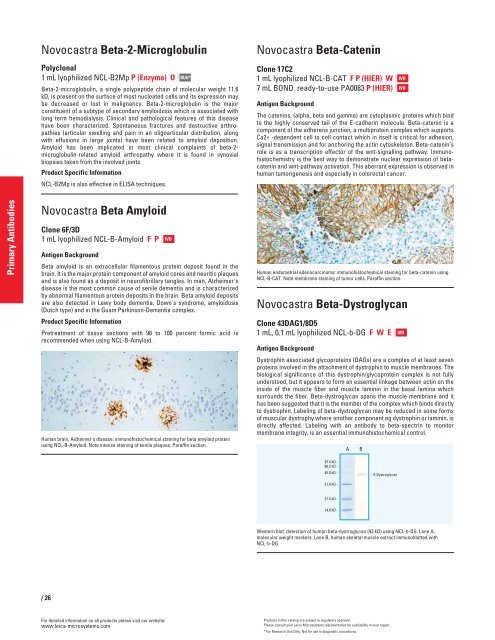QF0159 Marketing Release Record
QF0159 Marketing Release Record
QF0159 Marketing Release Record
You also want an ePaper? Increase the reach of your titles
YUMPU automatically turns print PDFs into web optimized ePapers that Google loves.
Primary Antibodies<br />
Novocastra Beta-2-Microglobulin<br />
Polyclonal<br />
1 mL lyophilized NCL-B2Mp P (Enzyme) O<br />
Beta-2-microglobulin, a single polypeptide chain of molecular weight 11.6<br />
kD, is present on the surface of most nucleated cells and its expression may<br />
be decreased or lost in malignancy. Beta-2-microglobulin is the major<br />
constituent of a subtype of secondary amyloidosis which is associated with<br />
long term hemodialysis. Clinical and pathological features of this disease<br />
have been characterized. Spontaneous fractures and destructive arthropathies<br />
(articular swelling and pain in an oligoarticular distribution, along<br />
with effusions in large joints) have been related to amyloid deposition.<br />
Amyloid has been implicated in most clinical complaints of beta-2microglobulin-related<br />
amyloid arthropathy where it is found in synovial<br />
biopsies taken from the involved joints.<br />
Product Specific Information<br />
NCL-B2Mp is also effective in ELISA techniques.<br />
Novocastra Beta Amyloid<br />
Clone 6F/3D<br />
1 mL lyophilized NCL-B-Amyloid FP<br />
Antigen Background<br />
Beta amyloid is an extracellular filamentous protein deposit found in the<br />
brain. It is the major protein component of amyloid cores and neuritic plaques<br />
and is also found as a deposit in neurofibrillary tangles. In man, Alzheimer's<br />
disease is the most common cause of senile dementia and is characterized<br />
by abnormal filamentous protein deposits in the brain. Beta amyloid deposits<br />
are also detected in Lewy body dementia, Down's syndrome, amyloidosis<br />
(Dutch type) and in the Guam Parkinson-Dementia complex.<br />
Product Specific Information<br />
Pretreatment of tissue sections with 98 to 100 percent formic acid is<br />
recommended when using NCL-B-Amyloid.<br />
Human brain, Alzheimer's disease: immunohistochemical staining for beta amyloid protein<br />
using NCL-B-Amyloid. Note intense staining of senile plaques. Paraffin section.<br />
/26<br />
For detailed information on all products please visit our website:<br />
www.leica-microsystems.com<br />
IVD<br />
RUO*<br />
Novocastra Beta-Catenin<br />
Clone 17C2<br />
1 mL lyophilized NCL-B-CAT F P (HIER) W<br />
7 mL BOND ready-to-use PA0083 P (HIER)<br />
Antigen Background<br />
The catenins, (alpha, beta and gamma) are cytoplasmic proteins which bind<br />
to the highly conserved tail of the E-cadherin molecule. Beta-catenin is a<br />
component of the adherens junction, a multiprotein complex which supports<br />
Ca2+ -dependent cell to cell contact which in itself is critical for adhesion,<br />
signal transmission and for anchoring the actin cytoskeleton. Beta-catenin’s<br />
role is as a transcription effector of the wnt-signalling pathway. Immunohistochemistry<br />
is the best way to demonstrate nuclear expression of betacatenin<br />
and wnt-pathway activation. This aberrant expression is observed in<br />
human tumorigenesis and especially in colorectal cancer.<br />
Human endometrial adenocarcinoma: immunohistochemical staining for beta-catenin using<br />
NCL-B-CAT. Note membrane staining of tumor cells. Paraffin section.<br />
Novocastra Beta-Dystroglycan<br />
Clone 43DAG1/8D5<br />
1 mL, 0.1 mL lyophilized NCL-b-DG FWE<br />
Antigen Background<br />
Dystrophin associated glycoproteins (DAGs) are a complex of at least seven<br />
proteins involved in the attachment of dystrophin to muscle membranes. The<br />
biological significance of this dystrophin/glycoprotein complex is not fully<br />
understood, but it appears to form an essential linkage between actin on the<br />
inside of the muscle fiber and muscle laminin in the basal lamina which<br />
surrounds the fiber. Beta-dystroglycan spans the muscle membrane and it<br />
has been suggested that it is the member of the complex which binds directly<br />
to dystrophin. Labeling of beta-dystroglycan may be reduced in some forms<br />
of muscular dystrophy where another component eg dystrophin or laminin, is<br />
directly affected. Labeling with an antibody to beta-spectrin to monitor<br />
membrane integrity, is an essential immunohistochemical control.<br />
Western blot: detection of human beta-dystroglycan (43 kD) using NCL-b-DG. Lane A,<br />
molecular weight markers. Lane B, human skeletal muscle extract immunoblotted with<br />
NCL-b-DG.<br />
Products in this catalog are subject to regulatory approval.<br />
Please consult your Leica Microsystems representative for availability in your region.<br />
* For Research Use Only. Not for use in diagnostic procedures.<br />
IVD<br />
IVD<br />
IVD
















